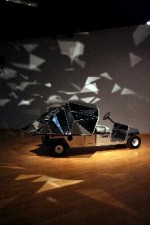Journey ‘Elsewhere’

As the hooded rioters set fire to the tourist office, the cheerleaders chanted, “Burn! Burn! Burn it to the ground!”
Never before has violence been accompanied by its own cheering squad, especially one scantily clad in miniskirts and equipped with pompoms. Flames continued to engulf the building while the fire department idly stood by, watching as the mayhem ensued. Among the arsonists and onlookers, an individual with a video camera documented the strange events, all of which took place this summer at USF.
Luckily, the tourist office wasn’t real – it was a façade built by Gregory Green’s sculpture class. The flames, on the other hand, were real, but were a planned part of the fake event. This “staged act of rebellion,” a performative piece by French artist Emanuel Licha, is titled “Preparing for Serious Events” and is on display at USF’s Contemporary Art Museum (CAM) as part of the current exhibit, Elsewhere.
The show is the first to be curated by David Norr since becoming CAM’s Curator of Exhibitions and Special Projects. The group exhibition includes
installation, film, video and sculpture that explore topics as varied and complex as globalization, colonialism, the romanticism of Victorian voyages and the recontextualization of literary narratives. The international artists embark on adventures around the world as a means of creating art, linked only by the notion of the journey, both conceptual and actual, real and imagined, experienced and performed. They travel to Shangri-La, the Galapagos Islands and the North Pole, among other places, searching for Utopia, natives untouched by Western culture and constructive elements for new directions in art.
“Shangri-La,” a video by artist Patty Chang, is inspired by modern reactions to James Hilton’s 1933 novel Lost Horizon. The book is about a British diplomat who discovers Utopia at a lamasery named Shangri-La after surviving a plane crash in the mountains of Tibet. Although the exact location of the monastery is never mentioned in the novel, several towns in China have claimed to be the basis for the story in an attempt to attract tourism. A war ensued among the competing towns until the Chinese government intervened and officially renamed one of the towns Shangri-La.
According to Chang, she was interested in the saga because of the “paradox of recreating the fictional vision of a colonialist writer.” The artist later traveled to Shangri-La and hired locals to make souvenir-like objects, including a cake decorated with an oxygen chamber, a mountain range made of mirrors and fantasy wedding photographs. “Mirrored Mountain,” an installation that is a re-creation of the mountain created by the locals of the utopian city, is on display at CAM, as well as the video of Chang interacting with the locals while trying to create the “perfect memory.”
This interest in souvenirs and interacting with locals is also found in “Souvenir,” a video by artist Stuart Hawkins. In the video, Hawkins is on a mission to seize and
capture the “Coco Man,” a native untouched by Western culture. She travels through Nepal on her journey, acting like a stereotypical Westerner, encountering the locals and recording their humorous responses to her performance. Hawkins finally tracks down the Coco Man, who turns out to not be what she expected, which raises questions about authenticity, expectations, the loss of identity and the economy of tourism.
Other highlights of Elsewhere include the abstract beauty and visual noise of Joachim Koester’s “Message from Andree,” a piece built around the last recorded memories of a doomed Swedish balloon expedition, and the earth-art dreamscape of “Mono Lake,” a video collaboration between Nancy Holt and Robert Smithson (best known for “Spiral Jetty”).
Elsewhere is on display at the Contemporary Art Museum until Oct. 12.






